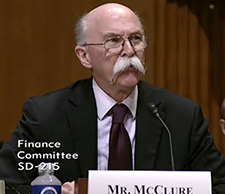In congressional testimony, urban planning researcher finds inadequacies in low-income housing tax credit
LAWRENCE — The federal Low-Income Housing Tax Credit, or LIHTC, is not adequately serving the country's lowest-income segment and should allow for more opportunities for tenant-based vouchers, among other changes, according to a recent report by a University of Kansas researcher of affordable housing issues and policy.
 "It is time to rethink how the LIHTC program works," said Kirk McClure, professor of urban planning in the School of Public Affairs & Administration.
"It is time to rethink how the LIHTC program works," said Kirk McClure, professor of urban planning in the School of Public Affairs & Administration.
McClure presented his research on the tax credit in early August during testimony to the U.S. Senate Committee on Finance as part of the hearing "America's Affordable Housing Crisis: Challenges and Solutions."
The LIHTC program is currently the country's most extensive affordable housing program. It was added to Section 42 of the Internal Revenue Code in 1986 in order to provide private owners with an incentive to create and maintain affordable housing.
In his analysis, McClure concluded the tax credit program:
- Does not produce units in the price range where there is typically a shortage for low-income renters
- Is not very successful in adding new units to tight housing markets and rehabilitating existing units in softer markets
- Favors new construction over rehabilitation of units independent of the market's condition
- Does not support mixed-income housing.
He recommends four changes to the program:
- More rigorous market analysis
"State Housing Finance Agencies, or HFA, should have to justify each LIHTC allocation by demonstrating a market need," McClure said, especially that an HFA should find vacancy rates are low and that a shortage of housing units exists at the price point to be served by proposed new LIHTC development.
- Exchange tax credit authority for voucher authority
Because housing authorities can convert up to 20 percent of their tenant-based voucher contract authority into project-based voucher authority, HFAs should be permitted to do the same thing under the tax credit. For example, the vouchers permit extremely low-income households to rent apartments in the market if the market conditions suggest this is the preferred approach, McClure said.
- Favor rehabilitation of units over new construction
"The LIHTC program should be modified so that it favors the appropriate type of development for each market," McClure said.
- Favor mixed-income development
"A development that is configured with a majority of units for low-income occupancy should be permitted only in a highly distressed area where mixed-income housing is not feasible," McClure said, "and the tax credit development contributes to a community revitalization strategy."